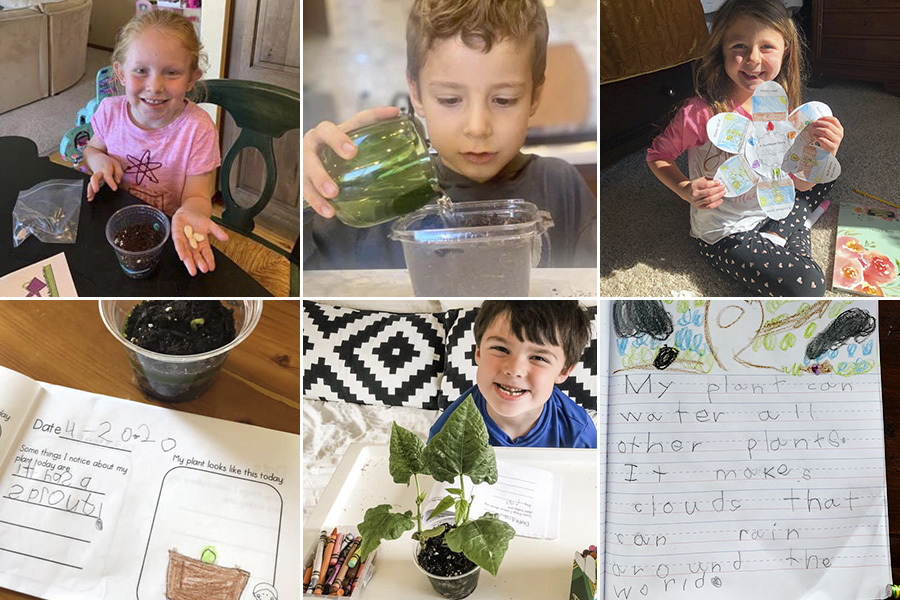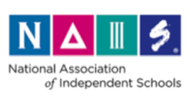Foundational skills in numeracy and phonological awareness remained as high priorities for advancing students skills but quickly our faculty identified practical goals:
- Concentrating on an intentional schedule for core academics that could be managed by families
- Embracing whole-heartedly our social and emotional resources such as mindfulness and advisory
- Adding continued opportunities to engage in synchronous co-curricular classes
“e-Learning has taught us a great deal in a short time about our students and ourselves,” said Jody Bates Bliss, the Children’s School Division Director. “With students in a virtual classroom, we have sought to continue building skills at the elementary level, alongside maintaining the relationships we hold so dear. The partnerships remain strong and authentic. And for everyone, it has pushed our resilience to new heights. All of this exemplifies what it means to be a Kodiak!”
Below, we highlight examples of e-Learning in prekindergarten through 3rd grade.
PreKindergarten: Ducks, Ponds, Birds & More
 Lessons in prekindergarten focus on hands-on activities that 3-year-olds and 4-year-olds create at home to deepen their learning. For one activity, students listened to the book Ducks Don’t Get Wet, and then their teachers posed the question, How do ducks stay dry? Students performed an experiment by using crayons to color a picture of a duck, then putting on small amounts of water.
Lessons in prekindergarten focus on hands-on activities that 3-year-olds and 4-year-olds create at home to deepen their learning. For one activity, students listened to the book Ducks Don’t Get Wet, and then their teachers posed the question, How do ducks stay dry? Students performed an experiment by using crayons to color a picture of a duck, then putting on small amounts of water. Kindergarten: Let’s Plant
First Grade: Kid, You’ll Move Mountains
First grade students are learning about mountain habitats through recorded lessons, slide decks, videos, and most exciting of all, experiments! First graders are given the directions and encouragement they need to complete experiments at home to further their understanding of mountains - their characteristics and how they are formed. They are encouraged to document their work with a photo or video that we can post for all to see!

Zara K. ’31 made a volcano and then poured in a vinegar mixture tomake it erupt, as shown in a video on the class Facebook page and shown in the screenshot shown here. Zara giggles as she hops up out of the way just before “the lava” gets to her.
Second Grade: Salt Dough Landform Writing Project
I was going to France with Jacob. We were going to celebrate the Fourth of July. I felt the plane start going forward and down. I was scared and wondered if I was going to land on an island. I randomly got on a life vest and jumped out of the plane with a parachute. I landed on my island in the middle of the Atlantic Ocean. It was fun! It was awesome! I could see people in France 100,000 miles away. They were surfing. I landed in a natural geyser. It was a good thing it was active because I would be stuck in there. I jumped out of the geyser and saw 2,086 active volcanoes. I wondered how it got there?
I needed to eat so I looked for food and water. I made a secret castle somewhere on the island. I find food covered in lava. I directed the lava. I direct the lava to the water so I can get food.
A great, great megalodon shark washes up on the shore. I direct the lava towards the shark. The lava heats up the shark and I can eat it. I save some meat for later. I got a bucket of water and dumped water into all the volcanoes. Now I could jump and swim around in them for a day. I made a home in the first volcano I saw. I made a jackhammer and dug a tunnel to my secret castle. There was a ginormous T.V. so I could play Minecraft all day!
I hiked around the island and heard, “Aaagh!” I saw a Yeti on the island. He’s nice on one day and then mean on the other. I like to be with the Yeti during the middle of the day. We play Minecraft in my castle. It’s fun!
It’s 2,000 degrees Fahrenheit every day. I hang out in my castle with Jacob and sometimes with the Yeti. I decide to live on Minecraft Island forever where everything is square.
Third Grade: Geometry Flipped-Video Instruction & Synchronous Time to Solve Problems
Teacher Alex Schilperoort introduces 3rd graders to a unit on geometry via a “flipped classroom” mini lesson in a pre-recorded video. Each day, students watch his mini lesson video and then complete problems “with him” in real time. This allows students to ask their teacher questions or for clarification if they are stumped. Finally, students are asked to complete the remaining problems on their own as their independent work.

“Doing math ‘alongside’ students in a virtual setting preserves a sense of normalcy for students, which is really important to maintain engagement and accountability,” he said. “Not only this, but it allows them to still experience our classroom community, albeit from a distance, giving them opportunities to talk and connect with their teacher and their peers.”
Creative Dramatics: Imaginary Tour Guide
If you could go anywhere, where would you go? In this project, students transport themselves anywhere in the world.
“This lesson focuses on activating the imagination and storytelling, which are two important elements in Creative Dramatics,” said Melissa O’Rear, Creative Dramatics Teacher for the Children’s School. “All students need is their imagination and a room in their house, and they can go anywhere they want! A floor becomes an ocean! A couch becomes a mermaid lagoon! What activities can you do in that place? What stories happen in this place? Students then create a map of their imaginary place and give a tour to someone in their home!”
Melissa prompts students by sharing a video of herself being an imaginary tour guide. The video, shown below, opens with her sitting on a couch in her living room.
Choose a room in your house and imagine you are in that place. Give your family a tour! Are there activities you can do in this place? Act them out! What do you see, smell and touch? Is there a historical background?
Students have the option to share their imaginary place with their teacher and classmates on Flipgrid, a video platform.
Parent Reflections & Testimonials
Parents have shared a wide-range of emotions during this process, but the accolades for the school have far outweighed the expressed challenges. The school is committed to feedback and with each week is assessing feedback and making adjustments. Our masterful teachers and strong parent partnerships have allowed us to find high levels of success for students and families.
“I am so thankful for all of my kids’ teachers! What started out as a potentially stressful time has resolved itself into a rewarding opportunity learning alongside my boys,” said Natellie Ryan, P’35, P’33, P’31. “I am so impressed with how the teachers have so quickly changed the structure of how they teach to accommodate the situation. They have kept it fun, interesting, and used resources beyond what I thought was possible like bringing the Georgia Aquarium into our living room. However, I know now for sure that I am not a homeschooling mother.”
“One of my major concerns when my son started to use the e-Learning platform that CSS developed for the Pre-K students was the amount of time he would have to spend behind a screen, executing computer-based activities in order to comply with the program,” said Yvanne Vieuille P’34. “My doubt dispelled when I saw the way my son’s teachers succeeded in putting together an online program that perpetuates the philosophy of CSS. Each lesson and activity for the day rely on a concrete theme which offers a mix of academic instruction, real world examples, hands-on experiences, and nature-based education that challenge my son in many ways and keep him connected with a natural environment.”
“The e-Learning process at CSS has truly exceeded my expectations,” Arifa Kaderbhai P’31, P’29 said. “It has been evident that the teachers in 1st and 3rd grade have truly gone above and beyond in their attempts to continue to provide instruction to my girls. They are still teaching new content and continue to provide challenging activities that they can do at home. The live lessons have been invaluable, and I believe that we would have had a completely different experience had it only been pre-recorded lessons. I really appreciate the daily feedback that they give, which drives them to work hard. The teachers are always so positive as they conduct the lessons.”
“I don’t want to sugarcoat it for anyone — these past couple months have been difficult in so many ways and the transition to e-Learning was tough for both kids and parents. However, the reasons we love this school (amazing teachers, sense of community, friendships, compassion, etc.) are making a difficult situation a little brighter for my girls,” said Dr. Sarah Bartz P’31, P’29. “Days before the first week even started, her teachers contacted me to check in. They wanted to understand my goals, my fears, and my family’s challenges. And throughout the past month, they have continued to focus on my individual child’s emotional needs while still providing a top-tier education with small group teaching sessions and full class socialization opportunities. They’re offering everything from optional morning yoga to extra online tutoring to afternoon dance parties. I can’t even imagine how difficult the transition has been for the teachers yet they are providing more than I expected and doing it with a smile.”
Click here for more e-Learning Reflections and Testimonials.









